Young's Slits Multiple Choice Solutions
Q1. In a double slit interference arrangement the fringe spacing is w when the wavelength of the radiation is λ, the distance between the double slits is s and the distance between the slits and the plane of the observed fringes is D.
In which one of the following cases would the fringe spacing also be w?
| |
|
|
distance between slits and fringes
|
| A |
2λ |
2s |
2D |
| B |
2λ |
4s |
2D |
| C |
2λ |
2s |
4D |
| D |
4λ |
4s |
2D |

B
Q2.
The diagram represents the experimental arrangement used to produce interference fringes in Young's double slit experiment.

The spacing of the fringes on the screen will increase if:
A |
the width of the single slit is increased - |
B |
the distance XY between the two slits is increased - |
C |
a light source of lower frequency is used |
D |
the distance between the single and double slits is decreased - |

Q3.
Young's two slit interference pattern with red light of wavelength 7.0 × 10–7 m gives a fringe separation of 2.0 mm.
What separation, in mm, would be observed at the same place using blue light of wavelength 4.5 × 10–7 m?

Q4.
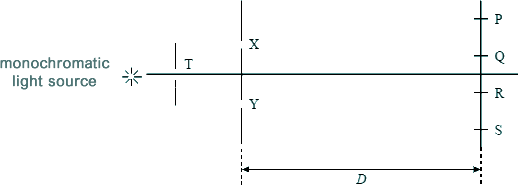
Coherent monochromatic light of wavelength λ emerges from the slits X and Y to form dark fringes at P, Q, R and S in a double slit apparatus.
Which one of the following statements is true?
A When the distance D is increased, the separation of the fringes increases. True!
B When the distance between X and Y is increased, the separation of the fringes increases.
C When the width of the slit T is decreased, the separation of the fringes decreases.
D There is a dark fringe at P because (YP − XP) is 2λ.

Q5.
Interference fringes, produced by monochromatic light, are viewed on a screen placed a distance D from a double slit system with slit separation s. The distance between the centres of two adjacent fringes (the fringe separation) is w. If both s and D are doubled, what will be the new fringe separation?
A w/4
B w
C 2w
D 4w

B
Q6.
In a Young’s double slit interference experiment, monochromatic light placed behind a single slit illuminates two narrow slits and the interference pattern is observed on a screen placed some distance away from the slits.
Which one of the following decreases the separation of the fringes?
A increasing the width of the single slit
B decreasing the separation of the double slits -
C increasing the distance between the double slits and the screen -
D using monochromatic light of higher frequency -

Q7.
A double slit interference experiment is performed using monochromatic light of wavelength λ. The centre of the observed pattern is a bright fringe.
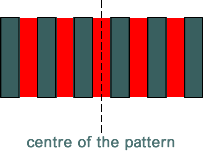
What is the path difference between two waves which interfere to give the third dark fringe from the centre?
A 0.5 λ
B 1.5 λ
C 2.5 λ
D 3.5 λ
Q8.
Interference maxima produced by a double source are observed at a distance of 1.0 m from the sources. In which one of the following cases are the maxima closest together?
A red light of wavelength 700 nm from sources 4.0 mm apart
B sound waves of wavelength 20 mm from sources 50 mm apart
C blue light of wavelength 450 nm from sources 2.0 mm apart
D surface water waves of wavelength 10 mm from sources 200 mm apart

A
Q9.
In a double slit system used to produce interference fringes, the separation of the slits is s and the width of each slit is x.
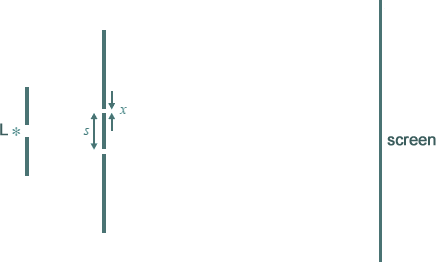
L is a source of monochromatic light.
Which one of the following changes would decrease the separation of the fringes seen on the screen?
A moving the screen closer to the double slits -
B decreasing the width, x, of each slit, but keeping s constant
C decreasing the separation, s, of the slits -
D exchanging L for a monochromatic source of longer wavelength -

Q10.
Two identical loudspeakers are connected in series to an a.c. supply, as shown.
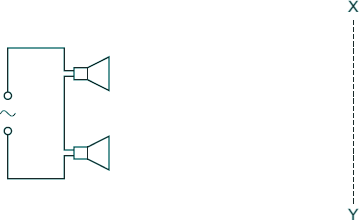
Which graph best shows the variation of the intensity of the sound with distance along the line XY?
The sound will never be fully destructive so answers B and C are not true.
The sound will be loudest in the central position and gradually get of lower intensity. the 'fringe width' will be the same - Choice D
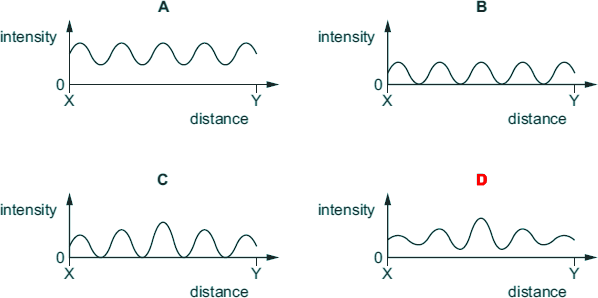
Q11. When a monochromatic light source is incident on two slits of the same width an interference pattern is produced. One slit is then covered with opaque black paper.
What is the effect of covering one slit on the resulting interference pattern?
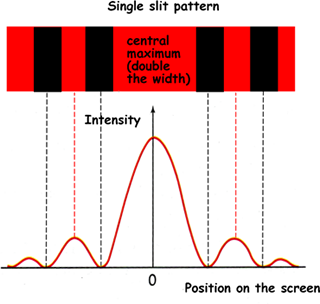
A |
The intensity of the central maximum will increase |
B |
The width of the central maximum decreases |
C |
Fewer maxima are observed |
D |
The outer maxima become wider |














